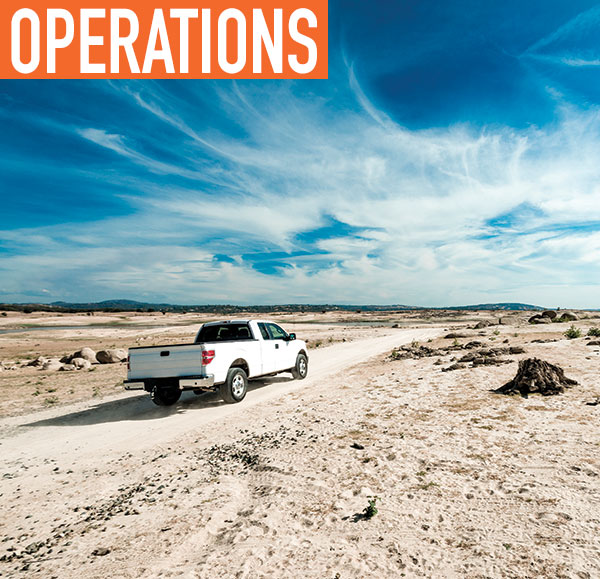Debates of the “he said, she said” variety are never fun to have. Yet, anyone that has rented or leased commercial trucks has dealt with this situation far too many times. Taking trucks on the road and out to worksites makes them susceptible to dings, dents, or general damages. Yet, who’s to blame for that damage?
Can you be sure that the damage was caused before you took the truck off the lot? Or, are you left wondering if you or your employees caused the damage?
When you consider the standard truck condition documentation process you see used by most rental and leasing companies, it’s no surprise you’re left scratching your head. You’ve likely seen lot agents walk around the truck with a paper form that includes the outline of a truck. Before the keys are handed over to you, they walk around the truck making small marks where any existing damage might be. But, those marks do not fully convey the extent of the damage or whether there are multiple types of damage in a single place.
Further, a simple walk around makes it easy to miss any existing damage in the first place.
Paper documentation makes it hard to pinpoint when and where truck damage actually occurred, meaning you could be accused of damage that happened well before you took the truck off the lot.
POOR DOCUMENTATION
It can be easy to brush off absorbing damage costs as just a natural part of renting and leasing trucks. In fact, it might be dealing with some of these day-to-day expenses that led you to rent rather than own your own work truck fleet. This passive approach to damages, however, could very well be hurting your business.
Consider the potential cost of damages themselves. For someone renting or leasing a commercial truck, damage to an axle can cost $3,000 to repair. Meanwhile, damage to a bumper and lift gate can take upwards of $6,000 to fully repair. The costs incurred from rental damage can take a large chunk out of the profits you’ve earned from doing the job itself.
In truck rental businesses, it’s not uncommon for 10 percent of all rentals to have some sort of damage dispute. For companies with large rental and leasing demands, this translates to the potential for extremely high damage costs. If you rent or lease trucks five times a month, that means you can expect six costly damage dispute issues every year.
Of course, we cannot forget insurance costs. Your insurance company knows exactly how many damage insurance claims you process, and they bake that into your insurance premiums. It’s likely you’re premiums are higher than they need to be.
The worst part of this is that you may not be at fault for any of these damages to begin with. Without a better way to track when and where damage occurred, you could be on the line for covering costs that should be paid for by the rental company.

WHAT TO EXPECT
Don’t you want to remove these costs, and the potential for disputes, entirely? With poor paper documentation being at the root of these issues, you’d be far better suited opting for rental companies that have transitioned to a digital documentation solution. What does this mean? It means companies that are incorporating the following features as part of each and every truck condition review.
Using photos and video: Do you see tablets or smartphones around your rental company’s office? That means they could be capturing high-resolution pictures and videos rather than using paper forms. Photos have the advantage of offering clarity to the extent of any existing damage. Additionally, integrating video into the documentation process means the company won’t miss any pre-existing damage. Even if a quick visual look at the truck shows no damage, you can always go back to the video and prove the damage preceded your rental.
Time-stamped documentation: You don’t want any uncertainty over when a picture or video was taken. After all, if damage occurred prior to the rental, you want to be sure you can prove those images showing damage were taken before the rental occurred. Time-stamped documentation goes a long way to all parties trusting the images’ credibility.
Integrated checklists: The last thing you want to be accused of is missing spare tires, owner’s manuals, or other valuable parts… Especially if they weren’t in the truck before you rented it. Rental companies that integrate checklists as part of their digital documentation process will ensure that employees remember to check these items prior to renting you the vehicle. This ensures a more thorough documentation on their end and peace of mind on your end.
Emailed documentation: You’ll always want a record of the photos, videos, and checklists that the rental company captured. After all, if a dispute does arise when you bring the truck back, you’ll be able to easily reference the original documentation and see if damage did happen under your watch.
Digital documentation is going a long way toward creating better relationships between truck rental and leasing companies and their customers. Better documentation means better transparency, allowing both sides to quickly settle damage concerns so they can go back to doing their actual business.
FOR MORE INFORMATION:
Shane Skinner is co-founder and CEO of Record360, a digital documentation solution for asset rental and leasing companies to decrease damage disputes and costs and boost customer service. Prior to founding Record360, Skinner worked as controller and business manager for Enterprise Rent-A-Car, where he was responsible for providing leadership and strategic direction for assorted business units, including vehicle rental, commercial truck, retail dealerships, and vehicle financing.
_______________________________________________________________________
MODERN WORKTRUCK SOLUTIONS: SEPTEMBER 2016 ISSUE
Did you enjoy this article?
Subscribe to the FREE Digital Edition of Modern WorkTruck Solutions magazine.
![]()




